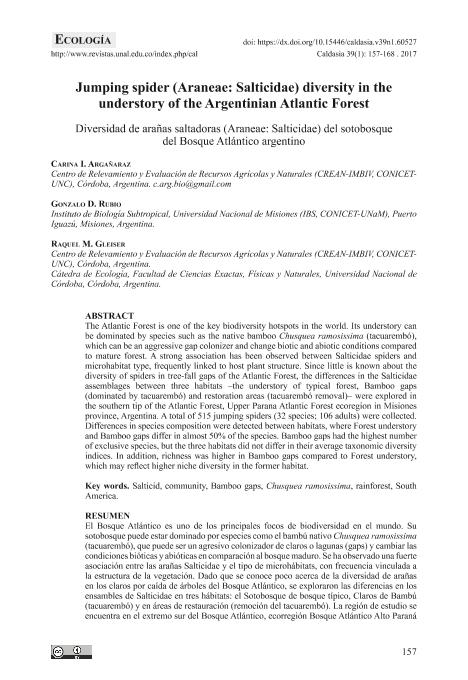Artículo
El Bosque Atlántico es uno de los principales focos de biodiversidad en el mundo. Su sotobosque puede estar dominado por especies como el bambú nativo Chusquea ramosissima (tacuarembó), que puede ser un agresivo colonizador de claros o lagunas (gaps) y cambiar las condiciones bióticas y abióticas en comparación al bosque maduro. Se ha observado una fuerte asociación entre las arañas Salticidae y el tipo de microhábitats, con frecuencia vinculada a la estructura de la vegetación. Dado que se conoce poco acerca de la diversidad de arañas en los claros por caída de árboles del Bosque Atlántico, se exploraron las diferencias en los ensambles de Salticidae en tres hábitats: el Sotobosque de bosque típico, Claros de Bambú (tacuarembó) y en áreas de restauración (remoción del tacuarembó). La región de estudio se encuentra en el extremo sur del Bosque Atlántico, ecorregión Bosque Atlántico Alto Paraná en la provincia de Misiones, Argentina. En total se colectaron 515 arañas (32 especies; 106 adultos). Se detectaron diferencias en la composición de especies entre hábitats, donde el Sotobosque y los Claros de Bambú difirieron en cerca del 50% de las especies. Los Claros de Bambú tuvieron el mayor número de especies exclusivas, no obstante, los tres hábitats no difirieron en sus índices de diversidad taxonómica media. Además, la riqueza fue mayor en los Claros de Bambú comparados con el Sotobosque, lo que podría reflejar una mayor diversidad de nichos en el primer hábitat. The Atlantic Forest is one of the key biodiversity hotspots in the world. Its understory can be dominated by species such as the native bamboo Chusquea ramosissima (tacuarembó), which can be an aggressive gap colonizer and change biotic and abiotic conditions compared to mature forest. A strong association has been observed between Salticidae spiders and microhabitat type, frequently linked to host plant structure. Since little is known about the diversity of spiders in tree-fall gaps of the Atlantic Forest, the differences in the Salticidae assemblages between three habitats -the understory of typical forest, Bamboo gaps (dominated by tacuarembó) and restoration areas (tacuarembó removal)- were explored in the southern tip of the Atlantic Forest, Upper Parana Atlantic Forest ecoregion in Misiones province, Argentina. A total of 515 jumping spiders (32 species; 106 adults) were collected. Differences in species composition were detected between habitats, where Forest understory and Bamboo gaps differ in almost 50% of the species. Bamboo gaps had the highest number of exclusive species, but the three habitats did not differ in their average taxonomic diversity indices. In addition, richness was higher in Bamboo gaps compared to Forest understory, which may reflect higher niche diversity in the former habitat.
Jumping spider (Araneae: Salticidae) diversity in the understory of the Argentinian atlantic forest
Título:
Diversidad de arañas saltadoras (Araneae: Salticidae) del sotobosque del Bosque Atlántico argentino
Fecha de publicación:
01/2017
Editorial:
Instituto de Ciencias Naturales
Revista:
Caldasia
ISSN:
0366-5232
Idioma:
Inglés
Tipo de recurso:
Artículo publicado
Clasificación temática:
Resumen
Palabras clave:
Bamboo Gaps
,
Chusquea Ramosissima
,
Community
,
Rainforest
,
Salticid
,
South America
Archivos asociados
Licencia
Identificadores
Colecciones
Articulos(CCT - CORDOBA)
Articulos de CTRO.CIENTIFICO TECNOL.CONICET - CORDOBA
Articulos de CTRO.CIENTIFICO TECNOL.CONICET - CORDOBA
Articulos(IMBIV)
Articulos de INST.MULTIDISCIPL.DE BIOLOGIA VEGETAL (P)
Articulos de INST.MULTIDISCIPL.DE BIOLOGIA VEGETAL (P)
Articulos(SEDE CENTRAL)
Articulos de SEDE CENTRAL
Articulos de SEDE CENTRAL
Citación
Argañaraz, Carina Inés; Rubio, Gonzalo Daniel; Gleiser, Raquel M.; Jumping spider (Araneae: Salticidae) diversity in the understory of the Argentinian atlantic forest; Instituto de Ciencias Naturales; Caldasia; 39; 1; 1-2017; 157-168
Compartir
Altmétricas




